Phoenix canariensis



Leaf scars or bases
Persistent leaf bases attached to the trunk or leaf scars that remain on the trunk.
Standard
A plant with a free standing erect stem and terminal foliage.This large spreading palm has a large solitary trunk with a rough diamond pattern. The dull green fronds grow 6m (20ft) long and form a large rounded crown and the creamy flowers appear in a branched cluster in spring followed by wrinkled orange fruit.
Phoenix canariensis Chabaud, is naturally found in the Canary Islands growing from the coast to the mountains on a variety of soils and habitats from humid to semi-arid regions appearing from sea level to an elevation of 600 m (1,968 ft). It has also naturalised in many countries and is regarded as a weed in Australia and California North America. It prefers a well drained poor to fertile moist organic rich sandy to loamy soil that is acidic to neutral with a pH range from 6.0 to 7.5. It grows in an open sunny to semi shaded position and is frost, wind, salt spray and drought tolerant with a preferred minimum winter temperature of -6ºC (21ºF).
The Canary Island Date Palm is a large palm that is grown for its rounded crown and its massive thick trunk. It is planted as a lawn specimen in large gardens and parks or used for avenue plantings. It is also be grown in containers when young and has a slow growth rate establishing in 3 to 6 years, forming a short trunk in 15 years and is long lived up to 150 years. This palm is used in gardens for a tropical effect and is transplanted when large for an instant effect in public places. It tolerates neglect but care should be taken when removing fronds as it has large spines which easily injure you. Once established it has a low water requirement (Scale: 1-drop from 3), preferring organic rich deep soil that is reliably moist but will tolerates dry periods.
I.D. 422
UK hardiness zone H1c
Climate zones 8, 9, 12 - 24
USDA Zone 9-11
Phoenix (FEE-nix) canariensis (ka-nair'-ee-ENS-is)
Etymology
Genus: Greek, Phoenix- from ‘phoinix’ from the Greek word for a Date palm or pertaining to bird and dark red
Species: Latin- canariensis – meaning (Canary Islands) referring to the region of origin
Note:
This plant is regarded as a weed in many regions as it can self-sow or spread vegetatively readily and is discouraged from use in gardens.

Canary Islands
Arecaceae (ar-ek-AY-see-ee)
(Palmae)
Palm Family
This family consists predominantly of tropical monocotyledons that form climbing and tree like habits with divided pinnate leaves and axillary inflorescence that produce ample indehiscent fruit.
Distribution
These plants are mainly distributed in tropical and warm temperate areas of the world from Central and South America to the Malay Peninsula and Africa in environments with poor drainage or permanent water such as mangrove swamps and low land rainforest. A small number of species are found in temperate regions.
Diagnostic Features
Palms are long lived and form solitary or multiple trunks that are rarely branched and can form a clump of, rarely with underground stems. They have a single apical bud and if it is killed by frost or mechanical damage the stem dies.
The leaves (fronds) of adult plants appear in regular numbers per stem at the apex with their tubular leaf bases clasping around the stem. These forms a pseudo-stem (crown-shaft) as in Arecoid palms or the dead leaf bases form a parchment-like weaved mat and may split below the petiole. The distinctive petiole is armed or unarmed with spines or teeth and leaf scars or leaf bases may be persistent on the trunk. They vary in size from 150 mm (6 in) to 25 m (82 ft) in length.
The leaf blade is plicate from bud and is normally simple and adult fronds are palmately, pinnate and occasionally bipinnate with pinnate ribs. Caryota spp. is palmately lobed simple with ribs and appears compound with the petiole acting as the rachis (Costapalmate). All have ligula terminating the petiole and have leaflets that fold upwards then down wards to the petiole or rachis and have one to several parallel nerved veins joined by transverse veinlets.
The inflorescence is simple or branched into a huge panicle and normally arises from the leaf bases and forms with a protective overlapping woody bracts that remains until the flowers developed.
The numerous small flowers occur individually or 2 - 3 together in a cluster and are monoecious or dioecious with the perianth segments in 2 whorls. The female flowers are generally 3 merious with 3 somewhat imbricate sepals and petals and have 3 stamens.. Male flowers sometimes have 4 petals and sepals. The flowers of pollinated by wind, ants, bees, beetles and flies.
There are three or more stamens and sometimes are adnate to the perianth or have the filaments joined into a tube or disk.
The gynoecium normally three-carpelled and may be fused or unfused. The ovary is superior with 3 carpels that have a single ovule and in many species only one ovule per flower that matures into one seed. The styles are rarely elongated and normally the arrangement is a three lobed fleshy stigma that is sessile on the ovary.
The fruit normally contains a single seed and it is a drupe or berry with a woody or fibrous surface that is smooth, prickly or hairy mesocarp is fleshy or dry and rarely produced 2 - 10 seeds.
The indehiscent seeds are commonly brightly coloured and have endosperm that is oily or fatty and a hard coated.
Note:
The palms have many uses from making spears to the fruit and leaf bases being eaten. There are of great horticulture importance and are used in many gardens.
This plant tolerates between USDA zones 9a to 11a and grows to 20 m (55 ft)
Fahrenheit 20º to 45º F
These temperatures represent the lowest average.
Celsius -6.6º to 7.2º C
Attention
This plant was last revised on the 3/3/2020
All photographs and data are covered by copyright. Apart from any fair dealing for the purpose of private study, research, reference or review, as permitted under the Copyright Act, no part including images and text may be reproduced by any means without written permission. The information presented in the map is only indicative and may contain errors and omissions. All inquiries should be addressed to sales@plantfile.com attention Peter Kirkland.

Compound
The leaf that is divided into separate units (leaflets).
Imparipinnate
A compound leaf that ends with a terminal leaflet.
Rosette
A cluster radiating from a common source.
Entire
A leaf margin with no irregularities (smooth).
Crateriform
A saucer shaped hollow.
Panicle
Branched with large loose clusters.| Jan | Feb | Mar | Apr | May | Jun |
| Jul | Aug | Sep | Oct | Nov | Dec |
The 6 mm (¼ in) wide creamy yellow crateriform male and female flowers appear on separate trees (dioecious). The large pendant panicle arises from a leaf base and is up to 2 m (6 ft) long, appearing during late spring.

Drupe
A succulent fruit composed of an outer fleshy layer "| Jan | Feb | Mar | Apr | May | Jun |
| Jul | Aug | Sep | Oct | Nov | Dec |
The green to orange 20 mm (3/4 in) wide drupes are globose to ovoid and contain wrinkled seeds. They appear in heavy clusters and are dispersed by birds and the crown is a breeding site for Indian Mynas, which are a pest in some countries.
The Canary Island Date Palm is a large palm that is grown for its rounded crown and its massive thick trunk. It is planted as a lawn specimen in large gardens and parks or used for avenue plantings. It is also be grown in containers when young and has a slow growth rate establishing in 3 to 6 years, forming a short trunk in 15 years and is long lived up to 150 years. This palm is used in gardens for a tropical effect and is transplanted when large for an instant effect in public places. It tolerates neglect but care should be taken when removing fronds as it has large spines which easily injure you.
Note:
In some regions this palm has become a weed and is difficult to remove due to its spiny leaf bases and quick growing root system.
This plant is susceptible to Fungal Leaf Spots,
Phytophthora Blight and False Smut.
Birds and possums nest in the crown.
The seeds take 2 to 3 months to germinate and seedling variation is common. Pot up soon after germination into deep pots.
Palm Seed
Palm seed should be sown as soon as possible after collection as the viability period is short, ripe mature fruit is essential. Do not allow the seed to dry out and if placed in a container of water any seed that floats should be discarded. After selecting seeds dust with a fungicide, as they are prone to fungal attack.
A soil mix composed of half peat moss and half perlite is a reliable media and then placed the containers over bottom heat of 28º C (80º F) and don't allow it dry out. It may take up to 1 or 2 years for germination of some species this may be accelerated by scarification or soaking the seeds in gibberellic at 1000 ppm for two days.
Propagation by Seed (General)
Germination
In order for a seed to germinate it must fulfil three conditions.
1. The embryo must be alive (a viable seed).
2. The seed must have no dormancy-inducing physiological, physical or chemical barrier to germination; also the seed must be nondormant.
3. The seed must have the appropriate environmental requirements, water, temperature and oxygen.
The interaction between these requirements and dormancy is complex and may lead to different environmental requirements that avoid the dormancy of a seed.
Sowing Seeds in Containers
There are two general methods for germinating seeds.
1. Sowing seeds in a flat or germinating bed, through which seedlings are pricked-out then, transplanted into another flat with wider spacing or directly to an individual pot.
2. Sowing seeds by placing them in to flats with the appropriate spacing or into individual pots.
This method is normally carried out with medium to large seeds such as woody plants and plants that are difficult to transplant.
Seedling production normally occurs in a greenhouse / glasshouse, cold frames and on hot beds.
Method of Seed Sowing
Fine seed is sown in pots or flats that are no deeper than 70 to 80 mm. using a sterilised well-drained media (soil). Fill the container to 20 mm from the top and sprinkle sieved peat to 3 mm depth.
Press the media down level and firm with a piece of timber and then thoroughly moisten.
Mix the fine seed with washed sand and then sow thinly on the surface. These may be lightly covered with sand.
Larger seeds may be covered with media or a hole is dibbled and the seed is placed in the media.
Watering Methods
For watering you may either mist the containers from above or place the container in tepid water and allow the water to raise through the pot to the surface of the media, then drain away and do not fill to the top of the container.
Place a piece of glass over the pot and store in a protected warm environment (glasshouse).
Seeds germinate best in darkness so shade the containers if in direct sunlight.
After the seedlings have sprouted remove the glass and ease the seedlings into direct light.
When the seedlings are large enough prick them out and transplant into larger containers then place them in a shade house to harden off.
Many seeds have different methods of seed preparation for germination such as nicking or cutting the seed coat to allow water penetration, also placing seeds in hot water and allowing it to cool off.
This is particularly important as it is softening the seed coat.
PEST
NAME
Scale Insect
Various Scale Species
ORDER
Hemiptera
Description of the Pest
Generally scales are soft bodied insects that have a hard (armoured) or soft covering to hide under. They have piercing and sucking mouth parts that are attached to the host, feed off sap and soft scales commonly producing sweet honeydew, which in turn attracts sooty mould and ants.
The adult female has a circular or oval covering depending on the species and is up to 8mm across. The first stage (crawlers) hatch and wander around the leaf surface until finding a suitable place to suck sap, normally in colonies and the smaller male is relatively inconspicuous.
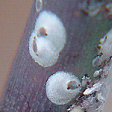 Hard Scale
Hard Scale 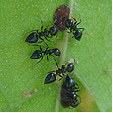 Soft Scale, attending Ants
Soft Scale, attending Ants
Cactus Scale (Diaspis echinocacti) has a circular greyish female and a narrow white male scale and is commonly found on house plants.
Chain Scales (Pulvinaria species) adult females are obvious with large group of eggs that are white or cottony-like, and the tiny young light green scales are flat and oval-shaped up to 2mm long. The legged nymphs are normally arranged from head to tail along the mid rib of the leaf, and may move to a new position to feed. They excrete honeydew and attract sooty mould and are found on Acacia and Acronychia species.
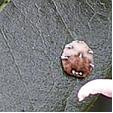 Chinese Wax Scale
Chinese Wax Scale
Chinese Wax Scale (Ceroplastes sinensis) is a domed wax scale that has dark spots around its margin and immature scales form waxy material around there margins.
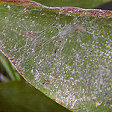 Fern Scale on Aspidistra elatior
Fern Scale on Aspidistra elatior
Fern Scale or Coconut Scale (Pinnaspis aspidistrae) appears as flecks up to 0.15mm long with a white covering over the male congregating on the underside of the fronds on the axils and among the sporangia causing them to turn yellow. Many species of fern are susceptible to infestation.
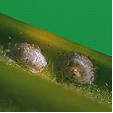
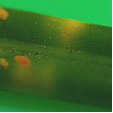 Flat Brown Scale
Flat Brown Scale
Flat Brown Scale (Eucalymnatus tessellates) are light brown up to 0.5mm long, flat and closely attached both sides of the leaf and causing yellowing of the foliage.
Juniper Scale (Diaspis carueli) is tiny and circular, white maturing to grey-black and as it feeds the needles turn yellow and die.
Oleander Scale (Aspidiotus hederae) is a pale yellow circular scale up to 3mm across and is found in dense colonies on the stem or leaves.
Tea-tree Scale (Eriococcus orariensis) are a creamy blue colour normally packed along the branches and are plump and rounded to 4mm across.

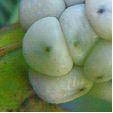 Wattle Tick Scale
Wattle Tick Scale
Tick or Wattle Scale (Cryptes baccatus) adult is domed, blue-slate colour with a leathery covering up to 10mm long. All stages of growth are found in groups of over forty, packed along the stems and normally tended by ants as they produce large amounts of honeydew. A serious pest of Acacia species found inland or coastal from temperate to sub tropical climates and commonly accompanied by Sooty Mould.
Toxic Scale (Hemiberlesia lataniae) is a tiny flat rounded scale up to 0.15mm long and is white to pale pink. It is normally found in colonies on the small branches and twigs of shrubs. It injects a toxic substance into the host as it sucks sap causing the death of the branch.
Wattle Scale (Pseudococcus albizziae) is soft, plump and secrets cotton-like threads. It is not a true scale insect and is simular to mealy bugs. It is reddish-brown up to 0.4mm long and secrets large amounts of honeydew as it sucks sap in colonies along the branches.
Life Cycle
These insects have a Hemimetabolous life cycle, ie. When the immature nymphs resemble the adults.
Appearance of the Pest
All parts of the plant above the soil may be attacked, but normally the stems and leaves and scale tends to favour well-lit positions.
Period of Activity
The nymphs and females are active for most of the year, in warm climates. Once they selected a position they attach and don't move. Normally the winged or wingless males are mobile and only soft scales produce honeydew.
Susceptible Plants
There is a wide range of susceptible plants including citrus, willows, holly, and many ornamentals, such as roses or Paeonia species. It also attacks indoor or glasshouse plants and Australian native plants such as wattles, hakeas, grevilleas and eucalyptus.
Acacia species are attacked by the Tick or Wattle Scale, which infest twigs and small branches and heavy infestations will kill the host plant.
Acer species are attacked by the Cotton Maple Scale (Pulvinaria innumerabilia) which prefers Acer saccharinum. Nymphs first attack the leaves and the brown adult scale is covered in a woolly mass up to 14mm across, normally found on the underside of the stems and twigs.
Acmena smithii, Melaleuca, Syzygium and Pittosporum species are attacked by the Chinese Wax Scale.
Aesculus species are attacked by several scale insects including the Walnut Scale (Aspidiotus juglans-regiae) which is saucer-shaped and attacks the main trunks.
Agave species are susceptible to several types of scale including (Aspidiotus nerii), (Aonidiella aurantii) and (Pinnaspis strachani), but generally do not require control.
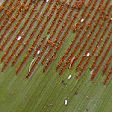 Asplenium australasicum
Asplenium australasicum
Asplenium australasicum is susceptible to Coconut Scale or Fern Scale (Pinnaspis aspidistrae). It is normally found on the under side of the fronds. Small infestations cause little damage.
Bougainvillea species may be attacked by the soft scale (Coccus hesperidum) outdoors or under glass.
Calluna and Vaccinium species are attacked by the Oyster Shell Scale (Lepidosaphes ulmi).
Camellia species may be attacked by the Florida Red Scale (Chrysomphalus aonidum), which is small, circular and black and is found firmly attached to the underside of the leaf along the veins. On inspection after removing the scale the insect has a pale yellow body. Camellias are also attacked by a large variety of scale insects including Tea Scale and Camellia Scale.
Carpinus species may be attacked by the scale (Phenacoccus acericola). It is found on the underside of the leaves forming a white cotton-like clump along the veins.
Casuarina and Allocasuarina species may be attacked by the Casuarina Scale (Frenchia casuarinae), a black hard scale that is upright to 4mm with a pinkish body. During attachment the surrounding tissue swells up and in time can, form galls. This weakens the wood and in severe infestations may kill the tree.
Cotoneaster species are attacked by up to four species of scale including the Oyster Shell Scale (Lepidosaphes ulmi).
Cupressus species are attacked by Bark Scale (Ehrhornia cupressi) is pink and covered in white wax. Heavy infestations cause the leaves to turn yellow or reddish.
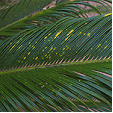 Flat Brown Scale on Cycas revoluta
Flat Brown Scale on Cycas revoluta
Cycads, palms and some species of Callistemon are attacked by the Flat Brown Scale.
Erica species are attacked by several species of scale including, Greedy, Oleander and Oystershell scale.
Jasminum species can be infested with up to twelve types of scale.
Juniperus x media and other conifer species are attacked by the Juniper Scale.
Leptospermum species are attacked by the Tea-tree Scale which produces ample honey dew that promotes sooty mould.
Palm and Fern species are susceptible to attack by the Coconut Scale or Fern Scale (Pinnaspis aspidistrae) which infests the underside of the leaves. They are also hosts for many other scale species such as red, cottony cushion and tea scale.
Pinus species are attacked by several species of scale including the Pine Tortoise Scale (Toumeyella numismaticum) and the Red Pine Scale (Matsucoccus resinosae).
Polygonum odoratum is attacked by a small brown scale.

Sorbus aucuparia is attacked by a five species of scale insect, including Black Cottony Maple, San Jose and Scurfy. Generally they suck on the sap of the new growth and leaves.
Strelitzia species are attacked by the Greedy Scale (Aspidiotus camelliae).
Damage Caused
Leaves become yellow and are shed prematurely and there may be twig or stem die-back. When the infestation occurs on fruit, the fruit is small and its skin becomes pitted and cracked. Small trees and saplings that are heavily infested may be seriously damaged or die. Sooty mould can cover fruit or leaves causing a secondary problem.
Cactus Scale can completely cover the host cactus sucking sap and causing it to die.
Cultural Control
Dead or damaged parts of the plant should be removed and destroyed including fallen fruit. Small infestations may be removed by hand or squashed on the stems. Healthy plants are less susceptible to attack, so maintain vigour of the plant and avoid using high-nitrogen fertiliser that produces excessive soft young growth.
When pruning susceptible plants paint the cuts with antifungal sealant paint as scale insects are attracted to the sweet smell of the sap. This will reduce the infection rate of the plant.
Biological Control
Natural predators such as parasitic wasps may reduce numbers of active nymphs; parasitic wasps are bred commercially in some areas for this purpose. It should be noted, however, that wasps would avoid dusty conditions.
Other predators that assist in control are assassin bugs, ladybirds, lacewings, hover flies and scale eating caterpillars. A variety of birds also attack scales.
The control of ants that transport aphid from one host to another also reduces infestation and can be carried out by applying at least three greased bandages 5mm apart around the stem or trunk of the plant.
Chemical Control
Spray the entire plant with dilute white oil solution; a follow-up spray may be required after four weeks, for heavy infestations. Spraying of chemicals will also kill of natural predators and in some cases the secondary scale infestation is more prolific especially when using copper based chemicals.
Some chemical controls, such as methidathion, are available - please seek advice from your local nursery as to the suitable product for your area.
Note
Always read the label for registration details and direction of use prior to application of any chemicals.
PEST
NAME
Two-spotted Mite, Red Spider Mite
Tetranychus urticae
ORDER
Acarina
FAMILY
Tetranychidae
Description of the Pest
Also known as the red spider mite. Females are pale green or yellowish, depending on the host plant, and have two dark lateral markings; the mite becomes red in winter, retaining their dark markings. Nymphs are six-legged, with another pair of legs appearing as the mite matures. Males are smaller and narrower. Fully-grown adults are just visible to the naked eye. Two-spotted mites spread by crawling between nearby plants or movement of dead leaves.
Appearance and Distribution of the Pest
Found world-wide; an introduced pest in Australia. They congregate in protected places, such as under bark and at the base of trees, during winter. During spring, they become green in colour, and migrate back into the leaves. During heavy infestations, the leaves may be covered in visible webs, which they spin as they feed. Leaves may eventually wither and fall. Mites can spread via the movement of dead leaves, or in webs that have become attached to birds or large insects. They initially appear on the undersides of leaves.
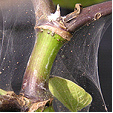
Spruce Spider Mite (Oligonychus ununguis) is a tiny greenish black adult which lays eggs on twigs where they overwinter. The pale green young spiders suck the sap turning the leaves yellow to brown. Heavy infestations form webbing and the pest is found on Abies and Juniperus species.
Banana spider mite (Tetranychus lambi) is a major widespread pest of bananas. It differs from two spotted mite by not producing copious amount of webbing. It is highly active during the dry spring to summer period and with the onset of the wet season mite numbers are reduced. The warm dry conditions that are created under plastic bunch covers is ideal for building up banana spider mite numbers.
Damage is normally confined to the underside of leaves appearing as rusty patches that coalesce along the leaf veins eventually turning the whole leaf brown-grey before it collapses. Fruit is damaged, close to the bunch stalk causing the area to become dull red purple-black, which in turn becomes dry then cracks.
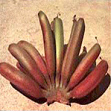 Damage fruit
Damage fruit
Control methods include careful water management during dry periods, and the reduction of dust from roadways. Regular desuckering and leaf trimming of plants will assist with a good coverage when spraying miticides.
Life Cycle
Mites have a gradual metamorphosis, with several nymphal stages. Each female lays up to 100 eggs that hatch in 7-14 days, with several generations appearing throughout the year. Females may become inactive during cold weather.
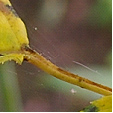 Webbing
Webbing 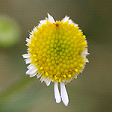
Period of Activity
The Two-spotted mite is most active in hot dry conditions. Under optimum conditions, the population can double every four days. It produces large quantities of webbing for over-wintering nests. Many plants are only susceptible to this insect when cultivated under glass.
Damage Caused
Adults and nymphs lacerated the undersides of the leaves with there rasping mouth parts, although infestations on both surfaces are not uncommon. Infestations cause leaf mottling leaf fall; premature leaf loss causes loss of vigour and reduces the quality and quantity of future crops. Repeated infestations, year after year, may weaken root growth and kill herbaceous plants.
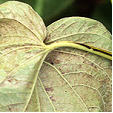
Susceptible Plants
A wide range of plants are attacked by the Red Spider Mite including annuals, fruit trees and vegetables, ornamental shrubs and trees.
Note
Many plant species are more susceptible to Red Spider Mite when they are cultivated under glass.
Other species of mite that are mentioned below have simular characteristics.
Calluna, Rose, Tropaeolum and Viola and species are infested with the Red Spider Mite (Tetranychus telarius) commonly in greenhouse situations.
Musa species are attacked by two spotted mite and banana spider mite damaging foliage and fruit.
Juglans species can be infested with up to four types of mites including red spider.
Cultural Control
Heavy rain or irrigation can reduce numbers; some plants may benefit from replanting in cooler locations. Generally, however, infested material should be completely removed and destroyed.
Preventative measures such as removing weeds or mulching around trees or shrubs or scrubbing the loose bark of susceptible trees during winter helps reduce numbers. During spring sticky bands can be wrapped around trunks close to the ground to trap the mites.
Biological Control
Natural predators include lacewings, ladybirds and thrips help keep the numbers down. Insecticide-resistant predatory mites (Typhlodromus occidenyalis) are also available commercially to control the Two-spotted Mite only on a large scale, as they require ample mites to survive.
Chemical Control
Spraying should be carried out as a last resort as many predators are killed during the operation and spraying can have the opposite effect by increasing numbers in the long term. Dimethoate will reduce numbers; however, Two-spotted mites are resistant to insecticides in some areas. Dusting with wettable sulphur may also prove effective.
Note
Always read the label for registration details and direction of use prior to application of any chemicals.
DISEASE
NAME
Leaf Spot (General)
Various Leaf Spot Species
Description
There is a wide variety of fungal leaf spots that infect perennials, shrub and trees. Some are specific to the host while others can affect a range of plants.
Symptoms
Generally light brown to purplish or blackish spots appear on the leaf and form concentric rings of fruiting bodies. The spots may leave holes, perforating the leaf or expand with pale green to yellowish margins and when the holes merge the leaf normally dies. There are many different types of leaf spot, some are discussed below.
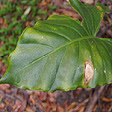 Alocasia species
Alocasia species 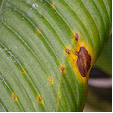
Alternaria Leaf Spot (Alternaria nelumbii) forms a small reddish brown spots that are boarded in light green, and as they develop in size the leaf curls and dies from the margin inwards. Normally occurs on Nelumbo species (water lilies).
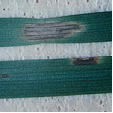 Helminthosporium Disease
Helminthosporium Disease
Helminthosporium Disease (Bipolris species), (Drechslera species) and (Exserophilum species) are responsible for several leaf spots that occur on all Turf Grass species. Generally they form black or white spots that may be faded and produce masses of spores in the thatch during late summer, under humid conditions. The life cycle is short and when conditions are favourable spores are splashed onto the foliage from the thatch, causing wide spread infection. Cynodon dactylon (common couch) is most susceptible and found in bowling or golf greens where it is a serious problem.
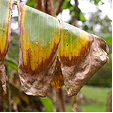 Banana Leaf Spot
Banana Leaf Spot 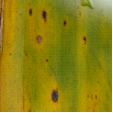
Banana Leaf Spot (Mycosphaerella musicola) is found on many species of banana causing pale yellow streaks on the young leaves to turn brown with dark spots. The leaf then becomes dried, brown and dead commencing from the margins, eventually the leaf dies. Control requires removal of infected foliage or the spraying of a fungicide and fungicides should not be used during the fruiting period.
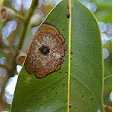
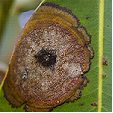 Lophostemon confertus (Brush Box)
Lophostemon confertus (Brush Box)
Leaf Spot on Brush Box (Elsinoe species). This is a casual fungus that attacks the epidermal layer of the leaf, forming circular spots that are up to 25mm across and are often restricted by the main vein. These spots are a dull yellowish brown but can also have purplish patterns. A leaf may have more than one spot develop on its surface and normally appears on scattered leaves throughout the tree. This doesn't affect the vigour of Lophostemon confertus.
Palm Leaf-scab (Graphiola phoeicis) appears as yellow spots and develop into scabs or warts that are outwards hard and dark but with a soft centre with powdery yellowish brown spores. The infected leaves eventually die.
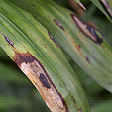 Palm Leaf Spot, Chamaedorea elegans
Palm Leaf Spot, Chamaedorea elegans
Palm Leaf Spot (Pestaloptiopsis species) appears as a small spot with a dark centre on the leaves and affects palms that are growing in shaded humid positions and normally control is not required, though infected fronds should be removed.
Source and Dispersal
Infection source is other contaminated plants and the spores are spread by wind or by splashing water. The fruiting bodies are black spots that appear on the damaged tissue releasing spores.
Favoured Conditions
This fungus prefers a warm humid environment and leafy plants with soft new growth, particularly if they are crowded.
Affected Plants
There are many ornamental and native plants that are hosts to a wide range of fungal leaf spots. Some specific ones are listed below. Plants such as Cornus or Paeonia species are infected by a large variety of leaf spots, while other plants attract a specific leaf spot.
Generally a healthy plant can tolerate fungal leaf spot attack, though it may make the plant look unsightly. In trees and shrubs it is difficult to control and generally not necessary, but in perennials and annuals control may be necessary in order to save the plant.
Acalypha and Arctotis species are infected by up to three leaf spots including (Cercospora acalyphae) and (Ramularia acalyphae) that rarely require control.
Acer species are infected by Purple Eye (Phyllosticta minima) which forms spots with brownish centres and purplish margins causing the death of the leaves.
Acer species are also infected by Tar Spot (Rhytisma acerinum) which forms round black spots that have yellow margins. Not normally seen on cultivated trees, but seen in forests.
Adiantum, Asplenium, Blechnum, Cyathea, Davallia, Nephrolepis, Platycerium, Polypodium and Pteris species are infected by the leaf spot (Pseudocercopora species) which forms circular brown spots on the fronds and heavy infection can defoliate a plant.
Aesculus species are occasionally infected with the leaf spot (Septoria hippocastani) which forms small brown spots.
Agave species are susceptible to the leaf spot (Coniothyrium concentricum), which appear as greyish spots up to 20mm (1in) across with concentric rings and black fruiting bodies. Affected leaves are destroyed as the infection spreads.
Albizia julibrissin is susceptible to the fungal leaf spot (gloeosporium aletridis), which does not normally require control.
Amelanchler, Chaenomeles, Crataegus and Rhaphiolepis species Mespilus germanica are infected by the leaf spot (Fabraea maculata) which may cause considerable damage during wet periods.
Aquilegia species can be infected by three types of Leaf Spot including (Ascochyta aquilegiae), (Cercospora aquilegiae) and (Septoria aquilegiae), normally appearing during humid conditions forming spots on the leaves.
Arbutus species are infected by two leaf spots (Septoria Unedonis) which produces small brown spots on the leaves and (Elsinoe mattirolianum).
Arctostaphylos manzanita is infected by the leave spot (Cryptostictis arbuti) which damages leaves but is not normally detrimental to the shrub.
Aspidistra species are infected by the leaf spot (Colletotrichum omnivorum) causing whitish spots on the leaves and petiole.
Aster species are infected by many leaf spots including (Alternaria species), (Cercosporella cana), ( Ovularia asteris) and (Septoria asteris).
Aucuba species are infected by several leaf spots, usually as a secondary infection after aphid attack. These include (Phyllosticta aucubae) and (Phyllostica aucubae).
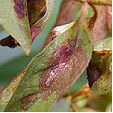
 Azalea
Azalea
Azalea (Rhododendron species) are susceptible to Leaf Scorch (Septoria azalea). This fungal disease forms reddish- brown spots which expand and engulf the leaf, with fruiting bodies appearing in the centre. Infected leaves die, then fall and the branchlets wilt. This problem is more serious during wet periods and may require control using a fungicide.
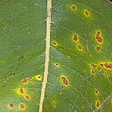 Banksia robur
Banksia robur
Banksia species are infected by several leaf spots causing chlorotic areas that have brown centres and is not normally a major problem for the plant.
Betula species may be infected by the Leaf Spots (Gloeosporium betularum) that forms brown spots with darker margins and (Cylindrosporium betulae) that also forms brown spots with faded indefinite margins.
Bougainvillea species are infected by the leaf spot (Cercosporidium bougainvilleae) which forms rounded spots with dark margins that yellowish ting. Infected leaves die and fall from the plant.
Calendula species are infected by the Leaf Spot (Cercospora calendulae) which rapidly infects the plant spotting the leaves and killing the plant.
Callicarpa species may be infected by the leaf spot (Atractilina callicarpae) forming irregular brownish spot or (Cercospora callicarpae) which can defoliate the plant in subtropical climates.
Campsis species may be infected by several fungal leaf spots including (Phyllosticta tecomae), (Septoria tecomae) and (Cercospora duplicata).
Carpinus species are infected by the leaf spots (Gloeosporium robergei), (Gnomoniella fimbriata) and (Septoria carpinea), all are minor infections not normally requiring control.
Carya species are infected by several leaf spots including (Gnomonia caryae) that infects leaves with irregular reddish spots on the upper surface with corresponding brown spore producing spots on the underside. It also has a secondary spore release that occurs on the dead leaves where it over winters. Other leaf spots include (monochaetia desmazierii) and (Marssonina juglandis).
Ceanothus species are susceptible to the leaf spot (Cercospora ceanothi) and (Phyllosticta ceanothi) both are of minor importance not requiring control.
Celtis species are infected by many leaf spots including (Cercosporella celtidis), (Cylindrosporium celtidis), (Phleospora celtidis) and (Septogloeum celtidis).
Chrysanthemums species are infected by the leaf spot (Septoria species) which forms yellow spots appear toward the edge of the leaves; these become enlarged brownish patches with yellow margins. Damaged areas may converge and in severe attacks and the leaves may fall prematurely or flower production is reduced.
Clematis species are infected by the fungal disease (Ascochyta clematidina) which may cause stem rot or leaf spots that are water soaked areas with reddish margins. The infection spreads from the leaves to the stem causing wilting and eventually girdling the stem killing the plant. There are many fungal leaf spots that infect this plant including (Cercospora rubigo) and (Septoria clematidis)
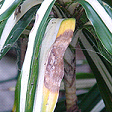 Dracaena deremensis
Dracaena deremensis
Cordyline and Dracaena species may be infected by the leaf spot (Phyllosticta maculicola) which forms small brownish spots that have yellowish margins and has black fruiting bodies that forms coils of spores. These plants are also susceptible to other leaf spots such as (Glomerella cincta) and (Phyllosticta dracaaaenae). Keep foliage dry to avoid infection.
Cynodon dactylon, Pennisetum clandestinum and many other Turf Grasses are susceptible to Helminthosporium Disease.
Daphne species are infected by the leaf spot (Gloeosporium mezerei) and (Marssonina daphnes) both of which form thickish brown spots that are seen on both sides of the leaves. Infected leaves turn yellowish before dieing.
Dendranthema species are infected by many leaf spots such as (Septoria chrysanthemi) which first forms yellowish spots up to 25mm (1in) across that become black. Infected leaves die prematurely and persist on the plant.
Dianthus species may be infected by the leaf spot (Septoria dianthi). It forms light brown rounded spots that have a purplish border. The scattered spots on the lower leaves can also be found on the stems and the spores are dispersed by water from the tiny black fruiting bodies.
Dieffenbachia species are infected by several leaf spot fungi including (Cephalosporium species) and (Myrothecium species).
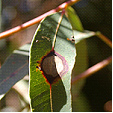 Eucalyptus species
Eucalyptus species
Eucalyptus species are infected by many fungal leaf spots such as (Mycosphaeralla species), (Hendersonia species) and (Monocheatia monochaeta). Generally leaf spots appear on the juvenile or new leaves causing brownish spots that enlarge and may have a purplish halo around the margin. Mature adult leaves are not normally infected and the trees rarely require control measures.
Fern species are infected by the leaf spot, (Alternaria polypodii). This fungus appears as brown circular or oblong spots that congregate along the margins of the pinnae causing the fronds to turn brown and die. It is spread by wind currents from plant to plant and control methods include removing infected fronds and maintaining a drier atmosphere.
Ficus species are infected by various fungal leaf spot including (Pseudocercospora species). Generally the fungal attack forms circular or irregular dark coloured spots on the leaves eventually causing them to fall prematurely.
Ficus elastica is susceptible to many fungal leaf spots including (Alternaria species), (Leptostromella elastica) and (Phyllosticta roberti).
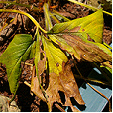
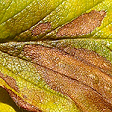 Strawberry
Strawberry
Fragaria x ananassa (Strawberry) is infected by the fungal leaf spot (Mycospharella fragariae). The mature leaf is initially infected with well defined brown spots that that turn light grey with red-purplish margins. As the spots merge they form large brown blotches and the leaf turns yellow then dies. This fungal attack normally occurs on plants in poor health and can be a serious problem early in the season seriously damaging stock.
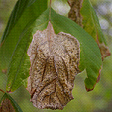 Fraxinus species
Fraxinus species
Fraxinus species are infected by the leaf spot (Gloeosporium aridum) giving the leaf a scorched appearance as large blotches appear from the margin or apex and turn brown with a papery texture. It is more prevalent during rainy periods and infected leaves fall prematurely. Collect and depose of fallen leaves otherwise control is not normally required.
Fuchsia species may be infected by the leaf spot (Septoria species) or ( Cercospora species), both form spots with dead centres and dark margins.
Gladiolus species are infected by Hard Rot or Leaf Spot (Septoria gladioli). On the corms reddish brown circular water soaked spots become large and sunken. These areas dry out and form obvious margins. The leaves may also have these symptoms but is not commonly seen.
Hemerocallis species are infected by several leaf spots including (Cercospora hemerocallis) and (Heterosporium iridis). These may be in the form of black spots or brownish spots that converge killing the leaf. Infected leaves should be removed and burnt.
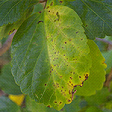 Hibiscus species
Hibiscus species
Hibiscus rosa-sinensis, Hibiscus syriacus and Hibiscus tiliaceus are susceptible to several fungal leaf spots including (Ascochyta abelmoschi), (Cerospora kellermanii) and (Phyllosticta hibiscina). All cause spotting or blotching of the leaf surface; remove and destroy infected parts.
Hydrangea species are infected by four fungal species including (Ascochyta hydrangeae), (Phyllosticta hydrangeae) and (Septoria hydrangeae).
Iris species are infected by several fungal leaf spots including (Alternaria iridicola) and (Macosphaerella species).
Iris species are also infected by the leaf spot (Didymellina macrospore) that forms greyish spots with brown water soaked borders and coalesce on the upper part of the leaf. This casual organism commonly occurs after flowering killing the leaves but will not infect the bulbs. The bulbs become weak over several seasons due to the decreased foliage.
There is also a Bacterial Leaf Spot (Bacterium tardicrescens) that is commonly mistaken as a fungal problem causing translucent spots that coalesce and involve the entire leaf. Normally found on Iris species.
Laburnum anagyroides is infected by the Leaf Spot (Phyllosticta cytisii). The leaf forms light grey spots with no definite margin and mature to brown. The black fruiting bodies appear as dots in the centre of the spot.
Leucanthemum species are infected by the leaf spot (Cerocspora chrysanthemi) and (Septoria leucanthemi).
Magnolia species are susceptible to many species including (Alternaria tenuis), (Mycosphaerella milleri) and (Phyllosticta species). Leaves generally turn brown from the apex or margins turning brown or spots appear on the leaf surface and leaves become yellow before withering and dieing. Normally the make the tree look poorly but have little effect on its growth. Control is not normally required.
Nerium oleander is susceptible to several fungal leaf spots including (Cercospora nerella), (Cercospora repens), (Gloesporium species) and (Phyllosticta nerii). Infected leaves should be removed but generally control is not required.
Nyssa sylvatica is infected by the leaf spot (Mycosphaerella nyssaecola) forming irregular purplish blotches.
Orchids such as Cattleya, Cymbidium, Cypripedium, Dendrobium, Epidendrum, Paphiopedilum, Phalaenopsis and Zygopetalum species are infected by several leaf spots including (Cerospora, Colletotrichum and Phyllosticta species). Normally forming dark or dead, circular or irregular areas on the leaves.
Palms such as Syagrus, Howea, Phoenix, Roystonea and Washingtonia species are infected by Leaf-scab (Graphiola phoeicis).
Palms such as Archontophoenix, Caryota, Chamaedorea, Cocos, Dypsis, Howea, Liculia, Linospadix, Livistona, Phoenix, Ptychosperma, Rhapis, Roystonea, Syagrus, Washingtonia and Wodyetia species are susceptible to several fungal leaf spots including;
(Bipolaris spp.), (Cylindrocladium spp.), (Colletotrichum spp.) and (Pestalotiopsis spp.).
Generally the circular leaf spots are brown and may have a yellow halo such as Palm Ring Spot (Bipolaris incurvata). They vary in size from small to large depending on the species. When a plant is healthy it recovers from attack, but heavy infections can defoliate, causing the collapse of the plant.
Palms are also infected by the Brachybasidium Leaf Spot (Brachybasidium pinangae). This fungus forms angular leaf lesions that produce fruiting bodies on the underside and is commonly found on Archontophoenix species.
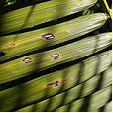
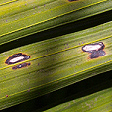 Archontophoenix cunninghamiana
Archontophoenix cunninghamiana
Passiflora species are infected with many types of leaf spot such as (Alternaria passiflorae).
Phoenix species are susceptible to False Smut (Graphiola phoenicis). This fungus forms yellow leaf spots that become hard with a raised with a blackish scab, which produces masses of powdery spores that are thread-like.
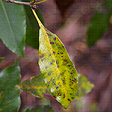
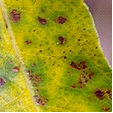 Pittosporum species
Pittosporum species
Pittosporum species are susceptible to the leaf spots (Alternaria tenuissima), (Phyllostica species) and (Cercospora pittospori). Circular or angular dark spots appear on the leaves and are surrounded by necrotic areas that are yellowish. Generally removal of infected leaves is adequate control.
Poa species and other cool season grasses are infected by Winter Fusarium Leaf Disease (Fusarium species), which causes small pale spots that are water soaked to appear on the leaves that turn red-brown. Infected leaves become bleached then wither and die, but the infection will not affect the crown or roots of the plant. It can be identified by pink, cotton-like mycelium and the plant prefers cold wet weather.
Populus species are infected by several fungal leaf spots including (Ciborinia bifrons, Ciborinia confundens), and (Mycosphaerella populicola).
Prunus species are infected by several leaf spots including (Cercospora circumscissa and Septoria ravenelii).
Pseudotsuga menziesii Douglas Fir is infected by the Leaf Cast (Rhabdocline pseudotsugae) Symptoms include the needles becoming yellowish at the apex and extending down the needle and spreading to others during moist spring weather turning them brown. Brownish scorched areas are noticeable on the tree from a distance. Control; is not normally required for mature trees but nursery stock may require spraying with a copper based fungicide.
Psidium guajava (Guava) is infected by (Glomerella cingulate). This fungus courses spots to appear on leaves and mummifies and blackens immature fruit or rots mature fruit. This fungus can devastate a guava crop.
Quercus species are infected by several types of leaf spot including (Cylindrosporium microspilum) and (Marssonina martini). These attacks tend top take place later in the season and normally not detrimental to the tree.
Rhododendron species are infected by a large variety of fungal leaf spots including (Cercospora rhododendri) and (lophodermium melaleucum)
Salix species are infected by several fungal leaf spots including (Ascochyta salicis) and (Septogloeum salicinum).
Senecio species are infected by the fungal leaf spot (Alternaria cinerariae) and (Cercospora species), forming dark rounded or angular spots.
Spiraea species are attacked by the fungal leaf spot (Cylindrosporium filipendulae).
Stenotaphrum secundatum (Buffalo) turf grass is susceptible to Grey Leaf Spot (Pyricularia grisea) in domestic and commercial situations devastating lawns. This fungal disease infects the stems and leaves with small brown lesions that enlarge rapidly forming grey-brown spots that have darker borders or surrounded by yellow chlorotic areas. This infection is commonly found on newly laid turf but will also infect established lawns. It is most prevalent during warm humid periods in soil with a high nitrogen level.
Syringa species are attacked by up to six species of leaf spot including (Cercospora lilacis) and (Phyllostica species).
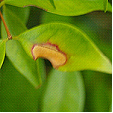 Syzygium species
Syzygium species
Syzygium species are infected by fungal leaf spots but normally control is not required.
Tagetes species are infected by the leaf spot (Septoria tageticola), which starts at the base and moves progressively up through the plant, covering the leaves in grey to black spots.
Trillium species are host to several leaf spots, including (Colletotrichum peckii) (Gloeosporium Trillii) (Heterosporium trillii).
Ulmus species are infected by many fungal leaf spots including (Gnomonia ulmea) and (Cercospora sphaeriaeformis).
Veronica species are infected by the leaf spot (Septoria veronicae). The symptoms include small violet to brown spots appear on the upper surface of the leaf and correspondingly yellowish brown on the underside. The spots converge forming a scorched shot-hole appearance and eventually death of the leaf.
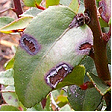 Vaccinium ovatum
Vaccinium ovatum
Vaccinium ovatum is infected by the leaf spot (Rhytisma vaccinii) and (Dothichiza caroliniana).
Vicia species are infected by the leaf spot (Erostrotheca multiformis), which forms greyish spots that enlarge and may defoliate the plant.
Wisteria species are infected by three fungal leaf spots (Phyllostica wisteriae), (Septoria wisteriae) and (Phomatospora wisteriae).
Non-chemical Control
Remove and destroy infected plant material and avoid overhead watering. When planting select infection resistant varieties. Practice crop rotation and add pot ash to the soil to decrease the plants venerability to the disease. Many species of fungus overwinter in fallen leaves, remove and destroy any litter under the plant.
Winter Fusarium Leaf Disease in Turf Grasses can be minimised by aerating the soil, reducing thatch and avoid excessive nitrogen in the soil.
Chemical Control
Protective fungicides such as zineb or copper oxychloride should be sprayed at the first sign of infection and cuttings should be sprayed as they start to grow.
Note
Always read the label for registration details and direction of use prior to application of any chemicals.
DISEASE
NAME
Leaf Blight (General)
Various Leaf Blight Species
Description
A fungal problem that attacks the leaves and may spread to other parts.
Symptoms
Generally light to dark brown patches or spots appear on the leaves. These join together causing the leaf to become dried and withered. Infected leaves fall prematurely and dieback occurs in the stems. The overall effect is a sparsely foliaged tree.
On Carrots the fungus (Alternaria dauci) forms small spots that turn the affected area yellow. This can spread over the entire plant resulting in the death of the plant.
Leptosphaerulina Leaf Blight (Leptosphaerulina species) infects Turf Grass. Generally the leaves turn light brown and wilt and from a distance, appear as irregular yellow brown patches. The leaves initially die back from the tip forming water soaked lesions that extend to the sheath and give them a bleached appearance. The fruiting bodies develop on the dead material and the spores are distributed by wind. This fungus appears on many grasses but is only a significant problem for Agrostis palustris (Bent) particularly during hot humid conditions.
Palm Leaf Blight (Pestalotia palmarum) forms grey brown spots on the leaf blades and penetrates into the leaflet axil turning the leaflets brown and killing the frond. Spores appear in black masses on the upper leaf surface. Another Palm Blight (Pestalotia palmicola) infects leaflet tips and progresses down throughout the frond turning it brown.
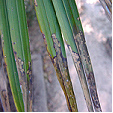
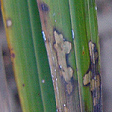
Strawberry leaf blight (Phomopsis obscurans) infects the leaves primarily with a triangular shaped patch that is reddish turning to brown. It is also found on the petioles and stolons and the tiny black fruiting bodies occur on damaged areas.
The fungal Leaf Blight (Didymascella thujina) forms brownish raised spots on small leaves tuning them brown during late spring and giving them a scorched, dead appearance, eventually falling from the plant during autumn. Commonly found on large Thuja species, but may also attack smaller varieties.
Umbrella leaf blight (Alternaria panax) forms dark brown to black patches that enlarge and distort immature leaves.
Source and Dispersal
The spores originate from other infected trees and are dispersed by wind or infected nursery stock. Once a plant is infected it can moves rapidly throughout. Certain species of tree can tolerate infection.
Favoured Conditions
It prefers humid still conditions with warm temperatures and is particularly a problem in tropical areas.
Affected Plants
A wide range of plants including vegetables, shrubs and trees may be affected.
Hibiscus species leaves are infected by Pellicularia koleroga a soil born fungus.
Leaf Blight (Pestalotia palmarum) infects several palms including Syagrus romanzoffianum and leaf blight (Pestalotia palmicola) attacks Phoenix, Syagrus and Washingtonia species.
Primula species are infected by the Leaf Blight (Phyllosticta prinulicola).
Syringa species are infected with the leaf blights (Cladosporium herbarum) and (Heterosporium syringae) which form large brown spots on the leaves that become dry and fall out.
Tilia species particularly young trees are in infected by the casual fungus (Cercospora microsora), which forms brown spots with darker borders, resulting in the death of the leaf.
Tsuga species are infected by the leaf blight (didymascella tsugae), which turns the leaves brown causing them to fall prematurely.
Non-chemical Control
On small trees remove and destroy the infected parts or in a nursery remove and destroy infected stock. Perennials and annuals should be removed and destroyed. Remove any fallen leaves from around the base of the plant as they contain fruiting bodies.
Chemical Control
Plants may be sprayed at five day intervals with copper oxychloride if possible. Turf infected with Leptosphaerulina Leaf Blight may be sprayed with a broad spectrum fungicide.
Note
Always read the label for registration details and direction of use prior to application of any chemicals.
DISEASE
NAME
Phytophthora Rot
Phytophthora species
Pathogen Name
A number of Phytophthora species cause these diseases but the most important species in Australia is the cinnamon fungus, Phytophthora cinnamomi. This species is exotic to Australia and probably originated from south east Asia; it has probably been present in Australia for close to 200 years. Phytophthora are fungal-like organisms that are related to some protozoa and algae; they are microscopic and cannot be observed by the naked eye.
Description
There are many types of Phytophthora Rot but generally the disease affects the plant by causing a soft rot of the affected plant part. The most common form of the disease is a rotting of the roots that occurs below ground with no visible symptoms of the disease above ground until the disease starts to cause leaf drop.
Symptoms
The disease is initiated below ground in the soil, usually on the feeder roots of a plant. The pathogen grows through the roots killing cells and eventually causing an extensive root decay. This causes the infected plant to lose vigour and the leaves to yellow and die. Entire branches starting from the top then die, quickly during hot weather or linger for months. The infection occurs on the root hairs causing small and large roots to rot. The symptoms of the disease are often very difficult to differentiate from drought symptoms, mainly because the affected root system prevents the uptake of moisture from the soil. Once the disease has progressed far enough large branches will die causing the typical dieback symptoms.
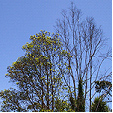
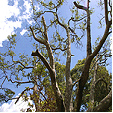
There are a number of other diseases caused by Phytophthora species
Twig Die Back (Phytophthora ilicis) attacks Ilex species causing black leaf spots and black stem cankers.
Phytophthora cactorum is known by several common names depending on which plant is being attacked and they have various symptoms. Plant species are listed below.
Root Rot (Phytophthora richardiae) infects Zantedeschia species causing the leaves to turn yellow, wilt and die. Flowers are deformed if they bloom and the infection can also be seen in the new growth, eventually killing the plant. On inspection the roots show signs of decay.
Stem Rot (Phytophthora cryptogea) infects the roots and stems turning them brown and seeds are also attacked causing decay. It is commonly found on Tagetes erecta and infected plants wilt, collapse and die.
Source and Dispersal
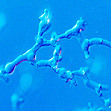 Sporangia
Sporangia 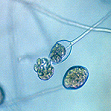 Zoospores
Zoospores 
Image by Dr Brett Summerell
Phytophthora species produce sporangia that contain specialised zoospores that have flagella that allow them to move through the soil moisture small distances. These spores encyst on the root and then penetrate the root. The pathogen also produces chlamydospores, specialised survival spores that allow it to survive in the soil for extended periods of time. The chlamydospores can be transported in soil, even extremely small amounts, allowing the pathogen to be dispersed very easily throughout an area and from one location to another. The zoospores are easily moved in water flowing through soil and so are easily dispersed down slopes. It is not uncommon for the disease to move in fronts down a slope.

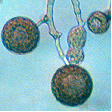 Chlamydospores, specialised survival spores
Chlamydospores, specialised survival spores
Image by Dr Brett Summerell
Favoured Conditions
Phytophthora root rot is favoured by poorly drained soils or in soils that are waterlogged for short periods of time. The disease generally occurs during periods when the temperature is above 16ºC although it has been observed in snow gum country in the Barrington Tops National Park and in southern Tasmania. It also prefers soils that have little organic material.
Affected Plants
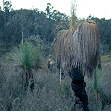
 Xanthorrhoea species
Xanthorrhoea species
Image by Dr Brett Summerell
The host range that is attacked by Phytophthora cinnamomi is enormous and is still not well understood but includes many Australian native plants, Rhododendrons, Acer and Prunus species, conifers, cabbage tree and strawberries. Some Australian plant families that are quite susceptible include species in the Proteaceae, Epacridaceae and Xanthorrhoea species.
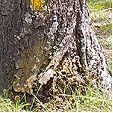 Alphitonia excelsa
Alphitonia excelsa
Alphitonia excelsa can be infected by Phytophthora cinnamomi causing loss of foliage, death of the upper branches and cankers on the trunk.
Cactus such as Cereus species may be infected with Slimy Collar Rot (Phytophthora cactorum) which forms a soft black area at the base of the plant that is water soaked.
Chamaecyparis species may be infected with the Root Rot (Phytophthora lateralis) that attacks roots, trunk, stems and leaves.
Cornus species are infected by Crown Canker (Phytophthora cactorum) and in this case the tree is partially infected initially with one side producing smaller leaves that turn reddish in late summer. The leaves may also shrivel and die prematurely, during dry periods and small and large branches die. After a couple of seasons the tree becomes completely infected with poor top growth and an inconspicuous canker develops at the base of the trunk. Eventually the tree dies.
Erica species are infected by (Phytophthora cinnamomi). The symptoms include foliage turning greyish towards the top, and then the plant wilts then dies with evidence of infection at the base.
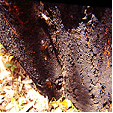 Phytophthora in Eucalyptus species
Phytophthora in Eucalyptus species
Image by B. Sonsie

Image by Dr Brett Summerell
Eucalyptus species are infected by Phytophthora cinnamomi causing rapid die back of the tree with blackened trunk loss or upper growth and is a serious problem for certain species such as Eucalyptus diversicolor (Karri).
Euphorbia pulcherrima is susceptible to Root Rot (Phytophthora and Pythium species). Roots become dark and the rot can extend up the stem. The plant is also susceptible to leaf blight resulting from the same fungal disease.
Hedera species are infected by Phytophthora Blight (Phytophthora palmivora). This fungus causes leaf spots, foliage blight and stem rot.
Palms such as Archontophoenix, Caryota, Chamaedorea, Cocos, Dypsis, Howea, Liculia, Linospadix, Livistona, Phoenix, Ptychosperma, Rhapis, Roystonea, Syagrus, Washingtonia and Wodyetia species are also susceptible to Phytophthora Blight forming large irregular areas on the fronds that become dark and rotten and limited by the veins
Lilium species are infected by Foot Rot (Phytophthora cactorum) which attacking the stems just below the soil level causing the plant to topple and if infection occurs as the leaves are emerging the base of the infected leaves which collapse remain attached to the bulb.
Morinda citrifolia is infected by Phytophthora Blight, black flag disease (Phytophthora species) which causes the foliage to turn black and limp. The fruit and stems are also infected causing them to turn brown-black and whither.
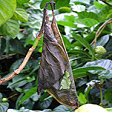
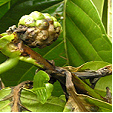 Morinda citrifolia
Morinda citrifolia
Orchids such as Cattleya, Cymbidium, Cypripedium, Dendrobium, Epidendrum, Paphiopedilum, Phalaenopsis and Zygopetalum species are infected by Black Rot (Phytophthora or Pythium species). This causes the leaves, pseudobulbs, rhizomes and roots to form a dark soft rot, normally occurring towards the base of the plant.
Saintpaulia, Dianthus, Gypsophila, Limonium and Anemone species are infected by Root and Crown Rot (Phytophthora nicotianae). This is a fast moving fungus that turns the roots blackish then extends to the crown and petioles causing wet rot of the crown then wilting, eventually killing the plant. When found as Phytophthora Leaf Spot or Blight, angular spots appear with water-soaked margins as in Cordyline and Philodendron species.
Sedum species can be infected by up to three Stem Rot fungi including (Colletotrichum species), (Phytophthora species) and (Pellicularia filamentosa). Commonly occurring in wet soils.
Ulmus and Acer species are also infected by (Phytophthora cactorum) and this is known as Bleeding Canker. This casual disease initially causes cankers in the bark that ooze sap and the sapwood forms reddish lesions with greenish margins. The leaves on affected branches turn yellow, wilt then die and mildly affected trees may survive.
Many species are infected by the Bleeding Canker including Acer platanoides, Acer rubrum, Acer pseudoplatanus, Acer saccharinum, Betula species, Liquidambar styraciflua, Aesculus x carnea, Tilia, Salix and Quercus species.
Non-chemical Control
The most effective control for all Phytophthora diseases is prevention primarily because it is extremely difficult to control Phytophthora diseases after they are established in the plant. As Phytophthora species are most easily transported in infested soil quarantine is an essential component of control of the disease and it is for this reason many areas have hygiene protocols to stop the pathogen being introduced into an area. It is recommended that bush walkers take care not to introduce the pathogen on their boots into un-infested areas and for this reason it is suggested that walking boots be cleaned and preferably sterilised (with 70% methylated spirits) prior to starting a walk.
Cultural techniques such as cultivating the soil regularly with added animal manure and other organic substrates to ensure there is good drainage will also help to minimise the impact of the disease. The plants can be mulched with straw or other organic material taking care that the base of the trunk is left clear. Avoid over watering the soil and observe hygiene in regards to tools, containers or shoes to reduce spreading the infection.
Potting mixes should be pasteurised for 30min at 60ºC to ensure that they are free of the pathogen. It is also very important to grow pots off the ground to prevent the splash of infested mix or water from an infected plant to clean plants.
.
Avoid damaging the bark particularly at ground level and seal any wounds that occur. If cactus or tree species are infected it is possible to cut out the infected area when first seen in order to contain it. Correct tree surgery techniques are required for large trees.
Chemical Control
There are a number of fungicides that are registered for use in the control of these diseases. The most effective chemical control are based on the use of chemicals containing potassium phosphonate. This chemical effectively enhances the defence systems of the plant and has been shown to be most effective in controlling Phytophthora diseases. It is essential that the chemical be applied when the plants is exporting nutrients to the roots, so this is best in the warmer months. The chemical can be applied as a stem injection or a foliar spray, and in some situations as a soil drench. There are specialised stem injecting equipment available for stem injections on larger trees.
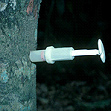
Image by Dr Brett Summerell
Note
Always read the label for registration details and direction of use prior to application of any chemicals.
Amendments by
Dr Brett Summerell
Director Science and Public Programs
Royal Botanic Gardens Trust, Sydney
DISEASE
NAME
Virus (Generally)
Various Virus Species
Viruses can infect any plant and there are hundreds of types, but unlike fungi and bacteria viruses can only reproduce inside a living cell. Viruses are small requiring a magnification of x 10,000 to be seen and infection can be transmitted from one plant to another causing a variety of symptoms. Infected cells normal function, in the plant is diverted to aid the virus to reproduce by supplying nutrients and energy. The virus can spread from cell to cell or travel through the vascular system in the plant and may only infect a specific part of the plant, normally the new growth or the whole plant.
Lethal Yellowing
This fatal disease is not a virus, but of uncertain origin that is associated with mycroplasmas or mycroplasma-like-organism and infects palms, particularly Cocos nucifera (Coconut Palm).
The symptoms include premature dropping of the fruit at all stages (shelling) and these have brown-black water soaked areas under the calyx. The second symptom is the blacking of the new inflorescence as it is exposed from the spathe. Male flowers are also blackish and fruit will not set.
The third stage of this infection causes the lower fronds to turn yellow, eventually engulfing the entire crown. The fronds turn brown and easily fall from the plant and the infection kills the entire plant within 3 to 6 months with the crown falling away leaving a bare trunk.
Some palm species only exhibit the third stage making it difficult to diagnose, but generally a solitary frond will turn yellow, known as 'Flagging' and indicates Lethal Yellowing.
It is known to be transmitted by a plant-hopper (Myndus crudus) and currently there is no practical control.
Mosaic Virus generally is a viral problem that involves several viruses altering the production of chlorophyll in the leaf. It may only be seen on certain parts but the whole plant will be infected.
Symptoms

Mosaic Virus on Roses form variable yellow pattens on some of the leaves that are fine lined, imitating the veins with blotches or larger marks forming streaks.
Mosaic Virus on Cabbage, cauliflower and broccoli form yellow rings on immature leaves that turn shades of green as the leaf matures and eventually turning purplish-black in cooler weather.
The virus (Marmor iridis) infects Iris and Watsonia species leaves develop pale green streaks on the leaf that become larger then turn brown eventually killing the leaf. The virus prevails in the rhizome from season to season and is a serious problem reducing and damaging flower production.
Phloem Necrosis (Morsus ulmi) is a serious disease of Ulmus species. The initial symptoms occur at the apex and on branch tips where the leaves droop as the petiole is affected. The leaf margins curve upwards and the leaf turns greyish then yellow and then falls, overall giving the tree a sparse appearance. As the virus matures it infects the phloem tubes turning them yellowish, and then brown eventually killing the cells. The roots die and the entire tree may gradually decline over eighteen months, or in acute cases a tree may die within three weeks.
Pumpkin and zucchini are attacked from a virus commonly known as 'Watermelon virus' which affects the leaves by making them mottled in light or dark green and may become distorted. This inhibits the size of the plant and the fruit may have sunken areas with concentric rings.
Tobacco is infected by a Tobacco Mosaic virus (Marmor tabaci) and a Ring virus (Annulus tabaci).
Tulip Breaking (Marmor mite) causes yellowish-white, light coloured striping or spotting of the flower and reduces the size and vigour of the plant in Tulipa species. It may also affect the growth of the bulb and offsets and is more prevalent in double-flowering varieties.
Yellows (Chlorogenus callistephi) is a viral disease that causes leaves to turn yellow and produces shoots that are simular to Witches Broom or flowers that have poor colouring. The infection will not kill the plant as it overwinters and spreads infection from the living host via the Leaf Hopper (Macrosteles fascifrons). It is not found in the soil or in seeds but is a major problem for Aster species.
Source and Dispersal
The source and the dispersal vary depending on the particular Virus that is involved. In roses the virus overwinters on fallen leaves or pruned pieces of plant material. It is also found on infected plants and is spread by infected propagation material. Aphids transmit this Mosaic Virus.
Infected cabbage, cauliflower and broccoli are an excellent source for aphids, such as the green peach aphid to disperse.
Iris rhizomes are the source and the virus (Marmor iridis) is spread by aphids and infected rhizomes during propagation.
Phloem Necrosis is thought to be transmitted by the Elm Leafhopper (Scaphoideus luteolus) or by infected rootstocks.
Pumpkin and zucchini are infected from surrounding weeds or other infected plants by several aphids including the cotton aphid and the green peach aphid.
Generally plants are infected by viruses by, rubbing against each other or through grafting, budding and other vegetative means such as wounds. Insects also transmit viruses by sucking sap or transferring infected pollen.
Favoured Conditions
Viruses prefer warm humid climate.
Affected Plants
A wide range of plants are affected from a range of Mosaic viruses causing simular symptoms. These include roses, cabbage, cauliflower, broccoli, iris, pumpkin, zucchini, turnips, capsicum, swedes, stocks, alyssum and wallflowers. Shrubs and trees such as Ulmus species are also infected.
Abutilon species may be infected by the Mosaic Virus ((Marmor abutilon) which causes variegation of the leaves.
Aquilegi, Berberis Passiflora and Tulipa species are infected by the Cucumber Mosaic Virus (Marmor cucumeris). This causes yellow streaking or mottling in the leaves and dark coloured patches to appear on the flowers. It also stunts the plant and prevents flowering.
Lilium and Tulipa species are infected by the Mosaic virus (Marmor mite) causing yellow mottling on the leaves.
Palms are infected by Lethal Yellowing include, Pritchardia martii and Phoenix canariensis.
Non-chemical Control
With roses if the problem is minor it may be ignored as the flower production will be normal. Heavily affected plants should be disposed of.
Other plants that are infected should be removed and destroyed. The spread may be arrested by the eradication of aphids by applying soapy water.
Chemical Control
Once the virus is seen it is too late to spray. Preventative spraying to control aphids should be carried out in spring using Dimethoate. There is no satisfactory chemical control for viruses.
DISEASE
NAME
Fusarium Wilt (General)
Various Wilt Species
Description
Fusarium wilt is caused by specialised strains of the common soil fungus, Fusarium oxysporum.This fungus is microscopic, and that can live in the soil for many years and primarily attacks plants by entering through the roots. This affects corms, stems and leaves by moving through the water conductive tissue in the plant.
The specialised strains are known as formae speciales (f. sp. or special forms) and each f. sp. has a relatively narrow host range. For example Fusarium oxysporum f. sp. cubense causes Panama wilt of banana, F. oxysporum f.sp. vasinfectum infects cotton and F. oxysporum f. sp. lycopersici attacks tomatoes. Each strain is specific to that narrow host range and will not affect other hosts; this is important as it makes control options involving the planting of other plant species possible.
Symptoms
Generally the plant wilts quickly during hot weather or lacks growth and vigour. Typically the symptoms are often indistinguishable from drought stress. Leaves yellow and wither or stems split open near the base. Individual branches may collapse and die or entire plants perish. One of the distinctive symptoms is a one-sided yellowing and death of a leaf or branch. Corms become rotted with open wounds and affected stems, when split open are yellowish. There are variations in the symptoms depending on the type of plant but generally plants wilt, turn brown and die.

Basal Rot (Fusarium oxysporum) infects Tulipa and Crocus species by turning leaves reddish, which wilt and normally die. It also affects the bulbs by forming few roots and rotting the base, turning them dull white.
This disease also infects cactus such as Cereus species and Zygocactus truncatus causing soft black rot that appears at the tips of the plant then spread rapidly downwards. It is particularly virulent in hot beds, under glass. The infected plants cannot be cured and should be disposed off site.
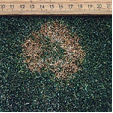 Fusarium Patch, Bent
Fusarium Patch, Bent 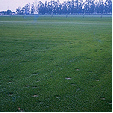 Fusarium Patch, Blue Grass
Fusarium Patch, Blue Grass
Other Fusarium (or related species) diseases
Fusarium Patch (Microdochium nivale formerly known as Fusarium nivale) is also known as Crown or Root Rot and infects warm or cool season Turf Grasses. The fungus infects the roots or rhizome turning them black, sometimes with a pink ting. During hot periods light green to brown patches appear in the turf as the damaged roots are unable to supply water to the leaves. This diseases is not a significant disease in Australia
Minimise irrigation of infected areas to reduce spread of infection as the spores are distributed in water.
Root Rot (Fusarium verticillioides) is a seed born fungus that infects Strelitzia reginae. It also forms a Leaf Spot in Dracaena species where rounded or irregular yellowish to reddish spots with a pail green border form. These are found on immature leaves and heavy infections may rot the crown.
Source and Dispersal
The fungal spores are dispersed by wind from infected plants or parts of plants. It is also dispersed by splashing water or contaminated stock or the movement of soil. With Fusarium wilt of canary island date palms the transfer of infected plant material on chain saws has been shown to be an important way in which the fungus can be transmitted from one tree to another. It is essential in these cases to sterilise the chain and chain bar between trimming the fronds on each tree.
Fusarium oxysporum produces three types of species, macroconidia, microconidia and chlamydospores. The latter two spore types play very important roles in the disease. The microconidia move in the vascular system of the plant and collect at the sieve plates in the xylem of plant. Here they germinate and grow and eventually block the sieve plate thus stopping the flow of water in the plant. The chlamydospores are specialised survival spores that persist in roots and in the soil for very long periods of time, thus allowing the fungus to survive periods when there are no susceptible plants present.
Favoured Conditions
The fungus prefers warm humid climates and is commonly seen in coastal regions and may continue living in soil for many years.
Affected Plants
Many species are infected including tomatoes, carnation, cucurbits and freesia. Die Back (Fusarium solani var. martii) causes damage to the branches of Ilex species. Fusarium also attacks palm species such as Phoenix causing wilt.
Albizia and Alternantera species are infected by the wilt (Fusarium oxysporum var. periciosum ) that causes the leaves to wilt, shrivel and die. This infection also extends to the branches and eventually may kill the tree.
Callistephus species are attacked by the wilt (Fusarium oxysporum f. sp. callistephi) which infects the vascular bundles turning brown, particularly on one side of the stem causing the plant to become stunted, eventually dieing.
Dendranthema and Thymus species are susceptible to the Stem Rot (Fusarium species) and (Pellicularia filamentosa) which rots the base of the stem.
Dianthus species are infected by Bud Drop (Fusarium poae). This fungus rots flower buds prior to opening and infected flowers open with distorted, unattractive petals. The control of thrips is essential. Dianthus species are also infected by Wilt (Fusarium oxysporum) that causes yellowing and wilting of the lower leaves, normally on one side. The infection causes stems to rot with vascular discolouration.
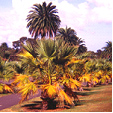
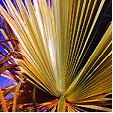 Fusarium Wilt Image by B. Sonsie
Fusarium Wilt Image by B. Sonsie
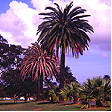
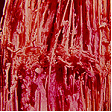 Image by Dr Brett Summerell
Image by Dr Brett Summerell
The only palms susceptible to Fusarium wilt are Phoenix species, especially Phoenix canariensis and juvenile Washingtonia filifera. Initially the leaflets turn yellowish then brown, on mature fronds causing them to die. Eventually only tufts of new growth remain the plant. As the infection continues the plant collapses and dies.
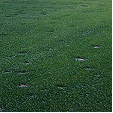 Fusarium Patch
Fusarium Patch
Turf grasses are infected by Fusarium Patch (Microdochium nivale). Plants include; Digitaria didactyla (Blue Couch), Cynodon species (Couch), Eremochioa ophiuroides (Centipede Grass), Festuca species, Paspalum vaginatum (Salt Water Couch), Pennisetum clandestinum (Kikuyu), Poa species (Bluegrass), Stenotaphrum secundatum (Buffalo) and Zoysia species. Generally the fungus produces small dead circular patches in the lawn.
Non-chemical Control
Fusarium diseases are extremely difficult diseases to control primarily because of a lack of a chemical control option and because the fungus is able to persist in soil for long periods of time. Crop rotation to non susceptible plants is advised and consequently it will be important to have the disease accurately diagnosed to ensure the identity of the pathogen and the possible rotation options.
Remove and destroy any infected plants. In the case of large trees or palms, it will be necessary to remove the infected plant, this not only means cutting down the above ground parts, but also removing the roots of the plant. These will then need to be removed and destroyed.
Fusarium Patch can be minimised by reducing thatch and aerating the soil regularly or improving the drainage.
Chemical Control
There are no effective chemical control options currently available for plant diseases caused by Fusarium species.
Note
Always read the label for registration details and direction of use prior to application of any chemicals.
Amendments by
Dr Brett Summerell
Director Science and Public Programs
Royal Botanic Gardens Trust, Sydney
Average Lowest Temperature : -1º C 30º F
USDA : 9, 10, 11
This USDA (United States Department of Agriculture) hardiness zone chart can be used to indicate a plant’s ability to withstand average minimum temperatures. However, other factors such as soil type, pH, and moisture, drainage, humidity and exposure to sun and wind will also have a direct effect on your plant’s survival. Use this chart only as a guide, always keep the other factors in mind when deciding where, when and what to plant.
A plant's individual USDA zone can be found in the Plant Overview.
Region of origin

Canary Islands
Climate Description
Warm to Sub-tropical
This overlaping zone has ample rain with high summer temeperatures and high humidity. Winters are mild. Pockets of sub-tropical climates exist within coastal warm temperate zones.
Frosts and droughts rarely occur along the coast.
Plant growth
Tropical and warm temperate native and exotic plants grow well.
| Dictionary | Growth Habit |
| Leaf Type | Botanic Flower Description |
| Leaf Shape | Flower Inflorescence |
| Leaf Arrangement | Fruit Type |
| Leaf Margin | Bark Type |
| Leaf Apex And Bases | Flower Description |